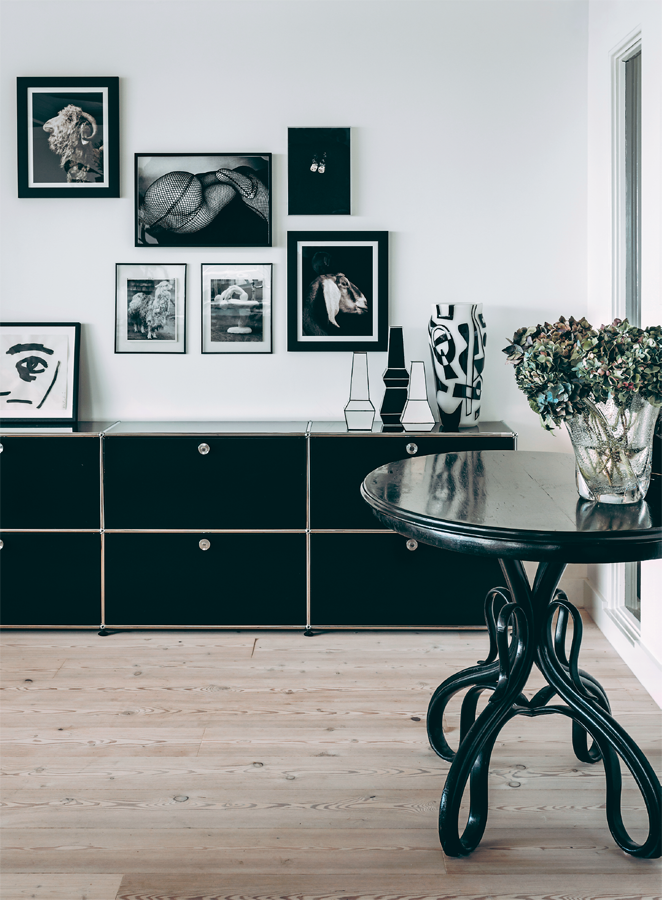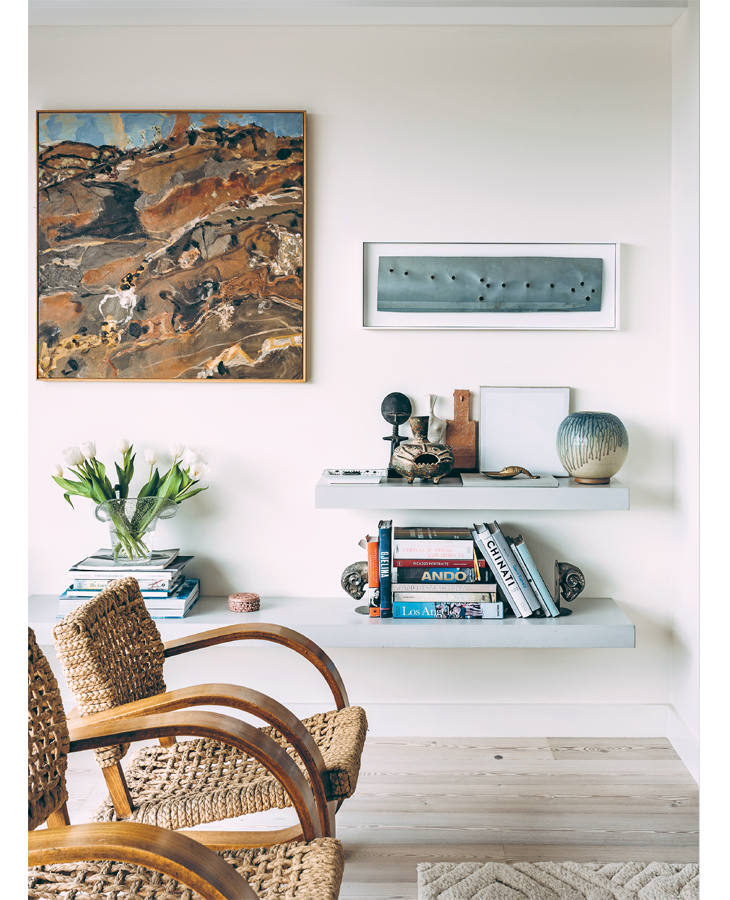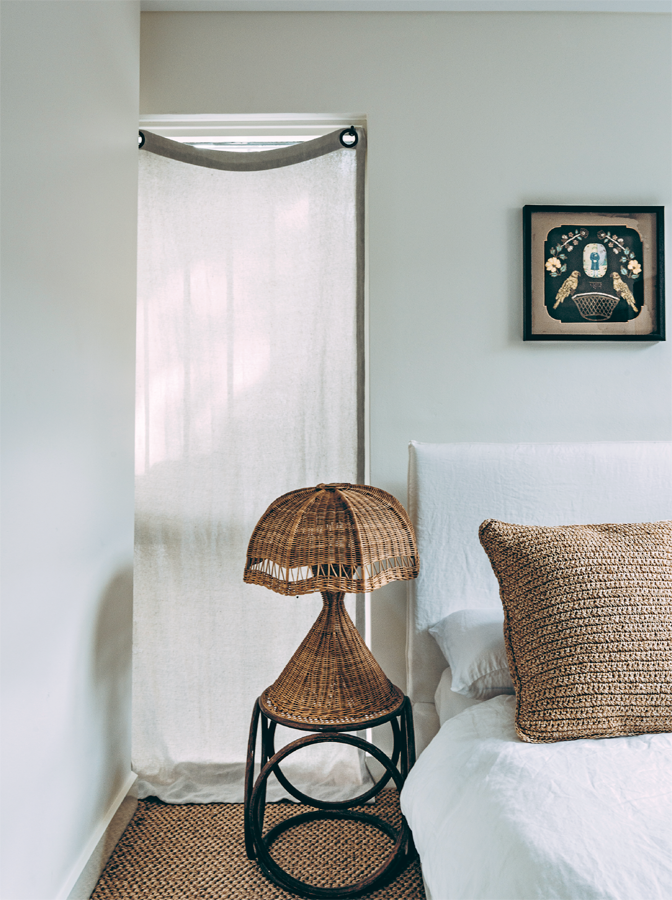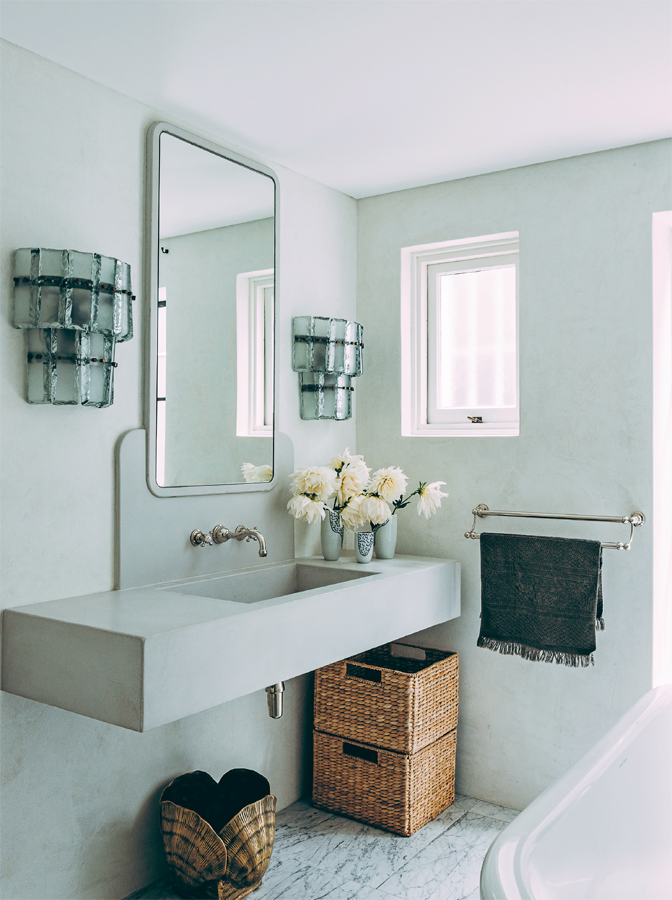TAMSIN
&
PATRICK
JOHNSON
EPHEMERAL
HOUSE
‘For me, the knack of appearing “effortless” cannot be underestimated. When someone can trust their own taste, and throw something together without being forced, it becomes the ultimate in sophistication.’
Tamsin Johnson

Tamsin is drawn to furniture that is assertive, that has a definite presence, such as this 1940s Belgian cabinet.

The interior appears resolved and settled, but is in a constant state of flux, with pieces being replaced as they find new homes.

A mix of monochromatic artworks hangs above a USM cabinet. The Thonet table, a family heirloom, is one of the few permanent elements in the house.

An awkwardly ecclesiastic chair, channelling the aesthetic of Frank Lloyd Wright, sits beside a commissioned work by Daniel Boyd.
TAMSIN & PATRICK JOHNSON
EPHEMERAL HOUSE
There is a portrait of Sydney interior designer Tamsin Johnson sitting surrounded by the contents of what was once her father Ed Clark’s antique shop in Melbourne’s Armadale – as much as anything, it seems to bring home the sense of her inescapable destiny. When they were children, she and her sister travelled the world with their parents in search of pieces to fill his shop and fuel Australia’s desire to own a slice of European antiquity. Two key observations she made are now embedded in her philosophy.
‘I discovered quality from a very young age, and learnt that good things would always be good,’ she says. The other is never to overlook the value of comfort. ‘I grew up in a house full of antiques where my friends used to joke about the comfort levels. They called the Louis XV jacquard upholstered sofa in the TV room “the bench”, and not in a good way.’
For a time, she chose fashion as a career path, training at RMIT in Melbourne before working for Stella McCartney in London. Eventually the pull of interiors was too strong, and she enrolled in a course at Inchbald School of Design. It was in London, too – in a pub in Notting Hill Gate – that she met her husband, tailor Patrick Johnson (or Patch, as she calls him).
Moving back to Australia, Tamsin worked for Sydney studio Meacham Nockles McQualter, designing restaurant and café spaces, retail stores and homes across Sydney and Melbourne. ‘I was with them for four years before setting up on my own, and am ever grateful for what I learnt during that period.’
Tamsin and Patrick’s collective aesthetic grew and merged as she designed his shop interiors – now in Sydney, Melbourne, New York and London – and they remodelled their present family home together. The P Johnson stores have developed an identity which reflects Patrick’s relaxed attitude to men’s suiting, moving away from the traditional cliché of a men’s club interior and introducing Tamsin’s flair for arresting art, bespoke pieces and iconic, if offbeat, furniture choices.
This is a trait that is on display at their own home overlooking the beach at Sydney’s Tamarama (or Glamorama as it is known locally). ‘The house was an original 1940s brick beachside cottage with a warren of rooms, none of which were open to the view,’ she says. A clean sweep of non-structural walls, the light touch of a white stain on the larch floor, and the shell was established for the introduction of pieces brought from their previous apartments in New York and Sydney’s Darling Point, alongside new finds gathered on her travels and internet searches.
‘For this space, I have seen my taste evolve as I am drawn to more subdued, muted tones,’ says Tamsin. ‘I think it is a response to the calm of the view.’ She and Patrick have been collecting art together, and the house celebrates those pieces in the way they are placed. A gallery wall of monochromatic works sits above a black USM cabinet, its linear precision balanced by an heirloom – a black Thonet table that lived in the family’s Lorne beach house before being co-opted as Tamsin’s desk for many years. Charming and accomplished as this vignette is, it is her love of the unique, one-off and specially commissioned pieces that sets her interior apart. ‘I try to avoid trends, trust my instincts and find things that resonate with me. If they ultimately find a client, then so be it, but I am happy to live with them in the meantime.’ The current coffee table will be gone in the blink of an eye, much to her husband’s puzzlement, but, she reassures him, the twin stone replacements sourced at an Italian antique fair, with their weirdly beautiful intersection detail, will leave this one for dead.
One has the feeling that Patch, little Arthur and his baby sister Azeline – Hector the British bulldog is still on probation – are the permanent things in her life. With the genetics of trading being part of her DNA, the joy that comes with sourcing the new outweighs the sadness of letting pieces go.
There is nothing apologetic in Tamsin’s world of things, and she likes her furniture and art to be gutsy, robust and have a high level of craft. The massive 1940s timber cabinet with verdigris copper detailing in her bedroom came from Belgian company De Coene Frères via her father’s shop; the assertive Frank Lloyd Wright-inspired chairs are from online site 1stdibs, and the pair of sought-after Adrien Audoux and Frida Minet rope armchairs from the 1950s were bought in France, and sent flat-packed to Australia. There is something about the textural honesty of the chairs that provides a material connection throughout the house in terms of cushions, bedside lights and other furniture pieces. Even the Belgian sisal on the floor anchors the more fanciful elements and relates it to the Australian coast. ‘I always think about context and make it my mission to filter out the design pastiche, the of-the-moment gesture and opt for things slightly out of kilter and offbeat. And are, of course, comfortable.’

There’s beauty in violence in the artwork, shot through with bullets, by Saskia Folk, alongside a painting by Luke Sciberras.

Rattan and sisal allude to the coastal context of the house. The Indian embroidery above the bed was a wedding present from Tamsin’s former boss, Don McQualter.

Murano glass lights were specially bought for this particular spot in the bathroom.

Tamsin bought the oil painting at an antique fair in Paris, and loves it for its Milton Avery-like palette. Continuity between the bathroom and bedroom is achieved through the Murano lights.

Collecting art has always been a shared passion of Tamsin and Patrick. Here, a tonal play of hard and soft materials illustrates something of the subtle magic of the interior.

The desk, bold in its design, was the kitchen table in their previous apartment.

Installing a built-in seat in the entryway and hanging a Pino Manos artwork gives a sense of purpose to what was a non-space.

The coastal setting, and the view of Tamarama beach, has informed many of the design decisions of the house, not least the colour palette.